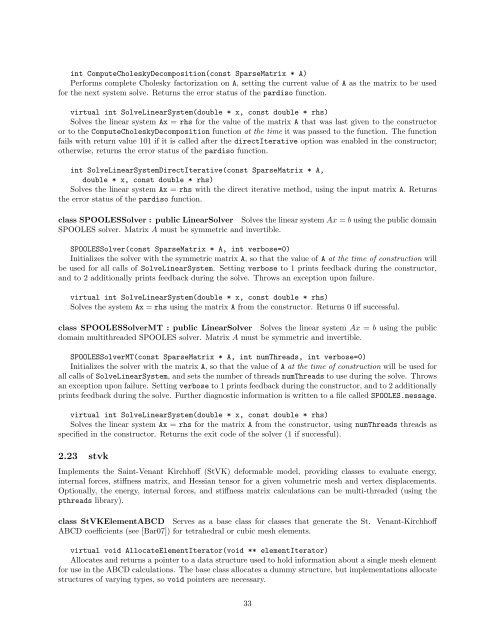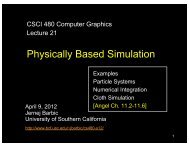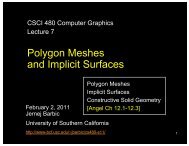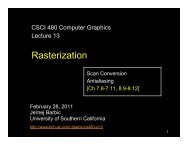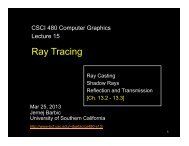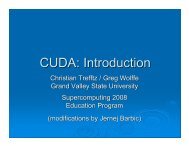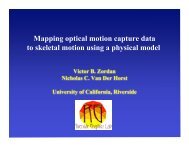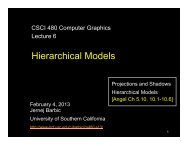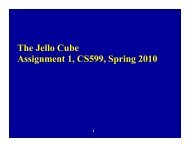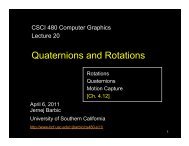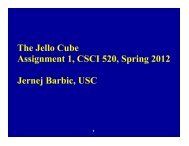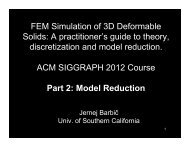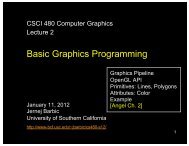Vega FEM Library (v1.1) User's Manual - University of Southern ...
Vega FEM Library (v1.1) User's Manual - University of Southern ...
Vega FEM Library (v1.1) User's Manual - University of Southern ...
Create successful ePaper yourself
Turn your PDF publications into a flip-book with our unique Google optimized e-Paper software.
int ComputeCholeskyDecomposition(const SparseMatrix * A)<br />
Performs complete Cholesky factorization on A, setting the current value <strong>of</strong> A as the matrix to be used<br />
for the next system solve. Returns the error status <strong>of</strong> the pardiso function.<br />
virtual int SolveLinearSystem(double * x, const double * rhs)<br />
Solves the linear system Ax = rhs for the value <strong>of</strong> the matrix A that was last given to the constructor<br />
or to the ComputeCholeskyDecomposition function at the time it was passed to the function. The function<br />
fails with return value 101 if it is called after the directIterative option was enabled in the constructor;<br />
otherwise, returns the error status <strong>of</strong> the pardiso function.<br />
int SolveLinearSystemDirectIterative(const SparseMatrix * A,<br />
double * x, const double * rhs)<br />
Solves the linear system Ax = rhs with the direct iterative method, using the input matrix A. Returns<br />
the error status <strong>of</strong> the pardiso function.<br />
class SPOOLESSolver : public LinearSolver Solves the linear system Ax = b using the public domain<br />
SPOOLES solver. Matrix A must be symmetric and invertible.<br />
SPOOLESSolver(const SparseMatrix * A, int verbose=0)<br />
Initializes the solver with the symmetric matrix A, so that the value <strong>of</strong> A at the time <strong>of</strong> construction will<br />
be used for all calls <strong>of</strong> SolveLinearSystem. Setting verbose to 1 prints feedback during the constructor,<br />
and to 2 additionally prints feedback during the solve. Throws an exception upon failure.<br />
virtual int SolveLinearSystem(double * x, const double * rhs)<br />
Solves the system Ax = rhs using the matrix A from the constructor. Returns 0 iff successful.<br />
class SPOOLESSolverMT : public LinearSolver Solves the linear system Ax = b using the public<br />
domain multithreaded SPOOLES solver. Matrix A must be symmetric and invertible.<br />
SPOOLESSolverMT(const SparseMatrix * A, int numThreads, int verbose=0)<br />
Initializes the solver with the matrix A, so that the value <strong>of</strong> A at the time <strong>of</strong> construction will be used for<br />
all calls <strong>of</strong> SolveLinearSystem, and sets the number <strong>of</strong> threads numThreads to use during the solve. Throws<br />
an exception upon failure. Setting verbose to 1 prints feedback during the constructor, and to 2 additionally<br />
prints feedback during the solve. Further diagnostic information is written to a file called SPOOLES.message.<br />
virtual int SolveLinearSystem(double * x, const double * rhs)<br />
Solves the linear system Ax = rhs for the matrix A from the constructor, using numThreads threads as<br />
specified in the constructor. Returns the exit code <strong>of</strong> the solver (1 if successful).<br />
2.23 stvk<br />
Implements the Saint-Venant Kirchh<strong>of</strong>f (StVK) deformable model, providing classes to evaluate energy,<br />
internal forces, stiffness matrix, and Hessian tensor for a given volumetric mesh and vertex displacements.<br />
Optionally, the energy, internal forces, and stiffness matrix calculations can be multi-threaded (using the<br />
pthreads library).<br />
class StVKElementABCD Serves as a base class for classes that generate the St. Venant-Kirchh<strong>of</strong>f<br />
ABCD coefficients (see [Bar07]) for tetrahedral or cubic mesh elements.<br />
virtual void AllocateElementIterator(void ** elementIterator)<br />
Allocates and returns a pointer to a data structure used to hold information about a single mesh element<br />
for use in the ABCD calculations. The base class allocates a dummy structure, but implementations allocate<br />
structures <strong>of</strong> varying types, so void pointers are necessary.<br />
33


